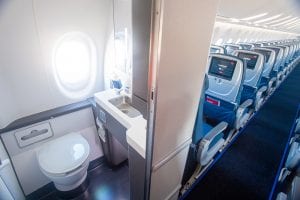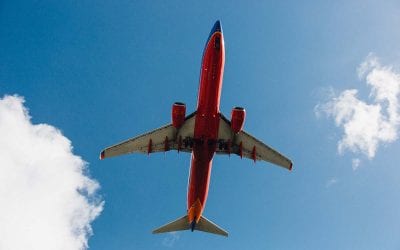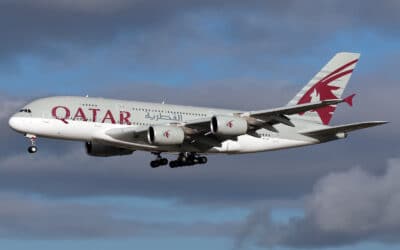Follow these suggestions for flying safe and healthy.
 The pandemic is well back in most everyone’s rearview mirror, including the airlines. Flying safe and healthy is a passenger’s responsibility again. The special attention to cleaning planes by airlines is long over.
The pandemic is well back in most everyone’s rearview mirror, including the airlines. Flying safe and healthy is a passenger’s responsibility again. The special attention to cleaning planes by airlines is long over.
Soon after boarding last week, a friend discovered a soiled diaper in the seatback pocket in front of his seat. On a flight from Atlanta recently, the seat pocket in front of me had a ton of used tissues in it.
With flights again packed and aircraft turnaround times tight, we must again take responsibility for our health when flying. Dirty pillows and blankets, dehydration, potable water, and DVT all pose health risks for air travelers that generally can be prevented.
Tests on high-touch areas of cabin seating and airplane lavatories show considerable bacteriological contamination.
 A few years ago, InsuranceQuotes performed surface bacteriological tests at three major airports and the airlines that serve them. They reported their results compared to germ counts found on typical household surfaces. The test results on planes showed, on average, 95,145 CFU (Colony-Forming Units per square inch) on the lavatory flush buttons, 11,595 CFU on tray tables, and 1,116 CFU on seat belt buckles.
A few years ago, InsuranceQuotes performed surface bacteriological tests at three major airports and the airlines that serve them. They reported their results compared to germ counts found on typical household surfaces. The test results on planes showed, on average, 95,145 CFU (Colony-Forming Units per square inch) on the lavatory flush buttons, 11,595 CFU on tray tables, and 1,116 CFU on seat belt buckles.
When you compare that to home surfaces of 361 CFU on kitchen countertops, 44 CFU on cutting boards, and 30 CFU on toilet handles, it screams that airline passengers are coming in contact with filthy surfaces on every flight.
The study went into more detail. On lavatory flush buttons, 82 percent of the germs were gram-positive cocci (GPC), organisms that can create serious infections, including pneumonia, skin, ear, and sinus infections. The tray tables had 65 percent CPC and 33 percent bacillus. Seat belt buckles had 45 percent GPC and 46 percent gram-negative rods. They’re associated with typical hospital-acquired infections.
Travelers need to sanitize their seat areas in the airplanes they fly.
Those numbers mean that air travelers must sanitize high-touch areas at their seats. To effectively disinfect your seat, use sanitizing wipes that contain hydrogen peroxide, isopropyl alcohol, or ethanol. Those chemicals ensure the wipes are highly effective. Before I sit in my seat, I use several wipes on my seat, the seat belt, the back of the seat in front of me, and my tray table. I never use the seat pocket in front of me or touch anything in it.
Travelers are better off not using airline pillows and blankets.
Another potential problem for air travelers are airline supplied pillows and blankets. Typically, they’re distributed in plastic bags. At the same time, plastic bags give the appearance of passengers being given clean pillows and blankets. Historically, they rarely are. The airlines typically clean them only every five to thirty days.
Bringing my pillow whenever I fly is a rule. Use a blow-up-style pillow. Please don’t bother with the blankets they give you because they may be dirty. I always wear layers when flying, so I don’t have a problem when the plane gets cold.
Dehydration due to dry, low-humidity conditions on airplanes can be a severe problem for air travelers.
Dehydration can be a serious problem for air travelers, especially on long flights. The typical humidity in most airplane cabins is about 20 percent, though, on Airbus A350 and Boeing 787 aircraft, it’s at about 25 percent. Those planes can have higher humidity due to the composite materials used to construct their fuselages. Even so, dehydration is a problem across the board.

The Mayo Clinic says straight water is probably the best bet to stay hydrated. I drink fruit juice, tomato juice, or bottled water while aloft. These products hydrate my body, counteracting the effects of the cabin environment.
E. Coli often contaminates aircraft potable water and poses a serious hazard for air travelers using it for beverages.
Water from the plane’s potable water system is another potential health issue. If you noticed above, I said I drink bottled water.
While it’s true that U.S. law requires the airlines to provide safe drinking water on their planes, it doesn’t appear that, as a practical matter, the law is working. In 2008, the Environmental Protection Agency (EPA) tests found that 15 percent of the aircraft tested carried water in their potable water tanks that tested positive for coliform bacteria. Coliforms can signal the presence of dangerous bacteria like E. Coli.
Eleven years later, in 2019, tests run by Hunter College’s New York City Food Policy Center and DietDetective.com on 11 major airlines and 12 regional carriers found that hardly any of the airlines tested passed testing for E. coli and coliform.
The airlines don’t seem to empty and clean their tanks often enough to ensure their water is safe. As a result, I recommend avoiding coffee and tea made with onboard “potable” water. As I said earlier, I drink fruit juice, tomato juice, or bottled water aloft. Each of these beverages is canned or bottled. The ice in my beverages it brought onto the planes in bags. It’s not made from water on planes.
Aircraft potable water is also a problem and risky for hand washing.
It turns out that the aircraft potable water problem is more of a problem than not drinking its water, tea, or coffee made using onboard water. The water poses a problem in the lavatory too. When you wash your hands in the lavatory, you may wash with water contaminated with E.coli.
Therefore, in addition to vigorously washing my hands with soap periodically in the lavatory, including after each time I use the toilet and push the flush button. Upon leaving the lavatory, I use hand sanitizer in case the water is contaminated.
Aircraft pressurization poses a serious problem of DVT for many air travelers.
In the air, airplanes are pressurized to an altitude of 6,000 to 8,000 feet. Older aircraft are pressurized to 8,000 feet. Newer aircraft like the Boeing 787 and Airbus A350, built with composite materials, are pressurized to a more comfortable 6,000 feet. Regardless, even in the newer aircraft, air pressure is considerably lower than at sea level. When you sit for hours, deep vein thrombosis (DVT) blood clots may occur for passengers who have had recent surgery, a malignancy, blood clotting disorders, or pregnant women.
On long flights, I periodically take walks down the aisle and stretch when permitted to combat the effects of reduced pressure. Exercise while seated. I extend my legs to the extent possible and flex my ankles and toes. I recommend you discuss wearing compression socks to combat DVT with your doctor.

READ ALSO:
For those struggling to find Global Entry interviews, use these tips
Why you should never recline your seat on a plane
After many years working in corporate America as a chemical engineer, executive and eventually CFO of a multinational manufacturer, Ned founded a tech consulting company and later restarted NSL Photography, his photography business. Before entering the corporate world, Ned worked as a Public Health Engineer for the Philadelphia Department of Public Health. As a well known corporate, travel and wildlife photographer, Ned travels the world writing about travel and photography, as well as running photography workshops, seminars and photowalks. Visit Ned’s Photography Blog and Galleries.



